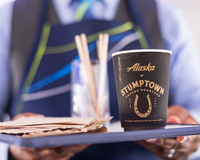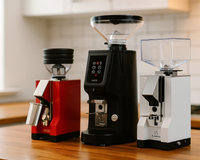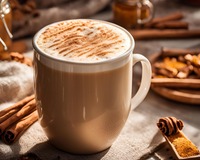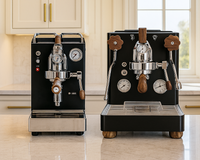What is Espresso Extraction?
Definition and Basic Principles
Espresso extraction is the process of brewing coffee by forcing hot water under pressure through finely-ground coffee. This method extracts a wide range of flavors and compounds from the coffee grounds, resulting in a concentrated, rich beverage known as espresso. The extraction process is central to the flavor, aroma, and body of the espresso. Three critical elements define espresso extraction: pressure, water temperature, and grind size. Pressure, typically around 9 bars, forces water through the coffee grounds, ensuring a fast yet thorough extraction. Water temperature, ideally between 195°F and 205°F, helps dissolve various compounds in the coffee. The grind size, finer than for drip coffee, increases the surface area of the coffee, facilitating a quick and efficient extraction.
The Role of Solubility in Coffee Extraction
Solubility refers to how well coffee compounds dissolve in water. Different compounds in coffee, such as oils, acids, and sugars, dissolve at varying rates. During espresso extraction, water acts as a solvent, extracting these compounds from the coffee grounds.
The solubility of these compounds is influenced by factors like water temperature, pressure, and grind size. For instance, higher temperatures increase solubility, allowing more compounds to dissolve. Similarly, finer coffee grounds increase the contact surface with water, enhancing extraction efficiency.
The Balance of Extraction: Under vs. Over Extraction
Achieving the right balance in espresso extraction is crucial. Under-extraction occurs when the extraction time is too short, or the grind size is too coarse, resulting in a weak, sour espresso. This happens because not enough compounds have been dissolved from the coffee grounds.
On the other hand, over-extraction occurs when the extraction time is too long, or the grind size is too fine, leading to a bitter, harsh espresso. In this case, too many compounds, including undesirable ones, are dissolved, overpowering the desirable flavors.
Identifying and correcting these issues involves adjusting variables like grind size, dose, and extraction time. For instance, a finer grind size or a longer extraction time can correct under-extraction, while a coarser grind size or shorter extraction time can address over-extraction.
YOU MIGHT LIKE: THE IMPORTANCE OF PRESSURE IN CREATING ESPRESSO AT HOME

Factors Influencing Espresso Flavor
Coffee Beans and Roast Level
The choice of coffee beans and their roast level significantly influence the flavor of espresso. Coffee beans can vary widely in flavor based on their origin, processing method, and roast profile.
Light roasts retain more of the beans' original flavors, often characterized by fruity and acidic notes. Medium roasts offer a balance between the beans' inherent flavors and the flavors developed during roasting, resulting in a more complex profile. Dark roasts, roasted for longer periods, emphasize caramelization and bring out bolder, chocolatey flavors.
Understanding the roast level helps in selecting beans that match your flavor preferences and adjusting the extraction process to highlight these flavors.
Water Quality and Its Impact on Flavor
Water quality is a critical yet often overlooked factor in espresso extraction. Since coffee is about 98% water, the quality of the water used can significantly affect the taste of the espresso. Factors like mineral content, pH level, and purity play a role.
Ideally, the water should have a balanced mineral content to enhance flavor extraction without causing scale buildup in the espresso machine. Water that is too hard or too soft can negatively impact the extraction process and the flavor of the espresso.
Using water filters or treatments can help achieve the optimal water quality for espresso brewing, ensuring consistent and high-quality results.
YOU MIGHT LIKE: WHAT GRIND SIZE DO I NEED TO MAKE ESPRESSO?
The Role of Pressure and Temperature
Pressure and temperature are two fundamental variables in espresso extraction. The standard pressure for brewing espresso is around 9 bars, which is necessary to force water through the compacted coffee grounds efficiently.
Temperature also plays a crucial role. Water temperature between 195°F and 205°F is ideal for extracting the right balance of flavors. Too low a temperature can result in under-extraction, while too high a temperature can cause over-extraction.
Modern espresso machines often allow users to adjust these settings, providing greater control over the extraction process and the ability to fine-tune the espresso to their taste preferences.
EXTERNAL LINK: Specialty Coffee Association's Guide on Espresso Brewing Standards

The Chemistry of Coffee Compounds
Key Compounds in Coffee
Coffee contains a variety of compounds that contribute to its flavor, aroma, and body. Some of the key compounds include:
- Caffeine: A stimulant that contributes to the bitterness of coffee.
- Lipids: Oils that contribute to the body and mouthfeel of the espresso.
- Acids: Various acids, such as chlorogenic acid, contribute to the acidity and complexity of the flavor.
- Sugars: Naturally occurring sugars in coffee beans caramelize during roasting, adding sweetness and depth.
Understanding these compounds helps in recognizing the flavor profile of the espresso and making adjustments to the extraction process to highlight or balance certain flavors.
The Maillard Reaction and Its Importance
The Maillard reaction is a chemical reaction between amino acids and reducing sugars that occurs during the roasting of coffee beans. This reaction is responsible for the development of complex flavors and aromas in coffee.During roasting, the Maillard reaction produces a range of flavor compounds that contribute to the rich, caramelized, and toasted notes found in coffee. This reaction continues until the beans reach the desired roast level, significantly influencing the final flavor of the espresso.
EXTERNAL LINK: The MAILLARD REACTION IN COFFEE ROASTING
Practical Tips for Better Espresso Extraction
Choosing the Right Equipment
Using high-quality equipment is essential for achieving the best espresso extraction. A reliable espresso machine and grinder are the foundation of any good espresso setup.When choosing an espresso machine, consider factors like temperature stability, pressure consistency, and ease of use. Similarly, a good grinder should offer precise grind size adjustments and produce consistent particle sizes.
Some recommended brands and models include:
- Espresso Machines: La Marzocco Linea Mini, Breville Barista Express, Rancilio Silvia
- Grinders: Baratza Encore ESP, Mazzer Mini E, Eureka Mignon Specialita
Dialing in Your Espresso
Dialing in refers to the process of adjusting various parameters to achieve the perfect espresso shot. This includes tweaking grind size, dose, and extraction time.Here’s a step-by-step guide to dialing in your espresso:
- Grind Size: Start with a medium-fine grind and adjust finer or coarser based on the taste.
- Dose: Measure the coffee dose using a scale. A standard dose is between 18-20 grams for a double shot.
- Tamp: Apply even pressure while tamping to ensure uniform extraction.
- Extraction Time: Aim for an extraction time of 25-30 seconds for a double shot. Adjust the grind size to achieve this time.
Consistency is key. Make small adjustments and taste the results, noting any changes in flavor and body until you achieve the desired profile.
YOU MIGHT LIKE: TROUBLESHOOTING A WATERY ESPRESSO PUCK
Maintaining Your Equipment
Regular cleaning and maintenance of your espresso machine and grinder are crucial for consistent performance and longevity. Residual coffee oils and particles can affect the flavor of your espresso and cause equipment malfunctions.Here are some maintenance tips:
- Daily Cleaning: Wipe down the machine, purge the steam wand, and empty the portafilter.
- Weekly Cleaning: Backflush the machine with a cleaning solution, clean the grinder burrs, and soak removable parts in warm water.
- Monthly Maintenance: Descale the machine, check for worn gaskets, and perform a thorough deep clean.
By maintaining your equipment, you ensure that every shot of espresso is as good as the first one.
YOU MIGHT LIKE: WHY YOUR WATER IS THE KEY TO PERFECT ESPRESSO

Conclusion
Recap of Key Points
In this article, we explored the science behind espresso extraction and flavor, covering essential topics like the principles of extraction, factors influencing flavor, the chemistry of coffee compounds, and practical tips for better extraction.Understanding these elements helps you appreciate the complexity of espresso and allows you to make more informed adjustments to your brewing process.















